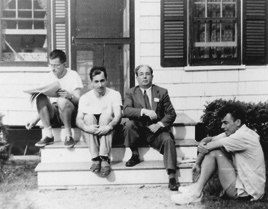1953: Viruses, Vol. XVIII
Organizer: Milislav Demerec
It was with the 1953 meeting that the "golden age" of Cold Spring Harbor Symposium began. It was this meeting that established the Cold Spring Harbor Symposia as the places to be to hear the latest in the new field of molecular genetics. The Symposia volumes for these genetics meetings served as primary sources of data in the years when Nature and Science were the only journals publishing in this area. And of this set of meetings—from 1953 to 1966—it is the 1953 Symposium that has taken on a mythic quality.
It was a perfectly timed meeting. Delbrück and Luria had begun promoting bacteriophage as a genetic organism in 1941 and they had established the annual summer Phage Course at Cold Spring Harbor in 1945. This course trained a new generation of geneticists, inculcated with Delbrück's view of how science should be done—quantitatively and critically. But Delbrück had heretics to contend with, most notably at the Pasteur Institute where Ellie Wollman, Andre Lwoff, Jacques Monod and Francois Jacob were studying the curious phenomenon of lysogeny. Delbrück was reluctant to believe in lysogeny but by 1953 it had become part of the accepted canon of the Phage Group.
Something of Delbrück's character is revealed in his introductory essay to the Symposium volume where he was unapologetic about the bias of the Symposium to bacteriophage and, to a lesser extent, animal viruses. The absence of plant viruses he justified on the grounds that the plant virus field had been animated by an "...extraordinary amount of controversy...unintelligible to the outsider." What was needed was for "our friends [in the plant virus field to] establish a party line among themselves, so we know what to compare with what." This was what Delbruck
| 
had done for the phage field when, in 1944, he had insisted on standardization, declaring that the proper subjects for phage research were the T-even phages and their host E. coli Strain B (the "Phage Treaty").
The list of participants reads like an honor roll of experimental virology-Anderson, Bertani, Cohen, Doermann, Hayes, Markham, Melnick , Stent, Vogt, Wyatt and Zinder, not to mention the twelve participants who would win Nobel Prizes in the course of the following 16 years! (These were Burnet, Delbrück, Dulbecco, Gadjuseck, Hershey, Jacob, Luria, Lwoff, McClintock, Palade, Tatum, and Watson)
But the Symposium achieved its mythic quality because of a last minute addition to the program. As Delbrück put it in his opening remarks, "The discovery of a structure for DNA proposed by Watson and Crick a few months ago, and the obvious suggestions arising from this structure concerning replication seemed of such relevance to many of the questions to be discussed at this meeting..." that the work had to be included. So it was that Jim Watson—immortalized in the Symposium photographs, tall, gangly and wearing shorts—made the first presentation of the DNA double helix at an open meeting.
— Jan A. Witkowski |